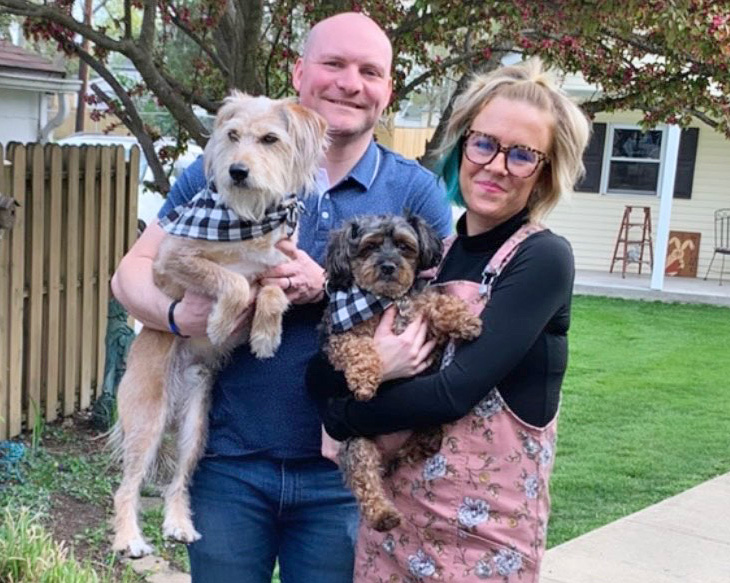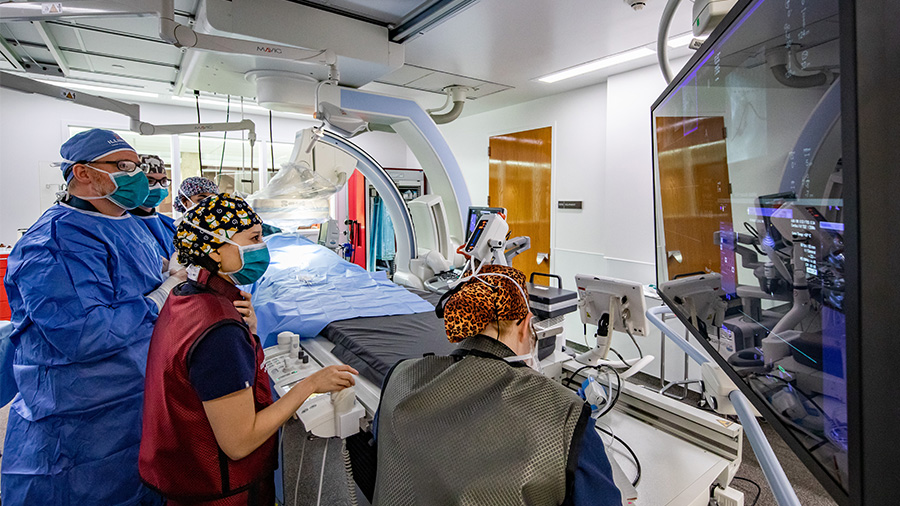“For most of its history, veterinary cardiology has been a specialty focused on diagnostics and medical management,” said Dr. Ryan Fries, who has led the Veterinary Teaching Hospital’s cardiology service since 2014.
“But what used to be impossible is now possible. We’re no longer limited to primarily one approach.”
Over the past two years, Dr. Fries and his colleagues have performed more than 40 interventional procedures to repair diseased heart valves in dogs. Chronic valvular disease is a life-limiting condition that affects as much as 7% of older dogs.

First TEER Patient
Murphy was 10 years old when he came to see the cardiology service in 2022. His veterinarian had made the referral after determining that Murphy’s recent bouts of rapid breathing related to a heart condition.
“The U. of I. cardiologists told us that Murphy had mitral valve regurgitation and was in congestive heart failure,” recalled Murphy’s human dad, Arik, of that first visit. That devastating news, however, came with a ray of hope.
“Because he was very healthy otherwise, they said Murphy might be a great candidate for a new procedure that could add years to his life.”
The new procedure, called transcatheter edge-to-edge mitral valve repair (TEER), had first been performed successfully on a dog in China in January 2020. This breakthrough treatment arose through a partnership between veterinary cardiologists from Colorado State University and a Chinese medical technology company.
By 2022, the Illinois cardiology team had been trained on the TEER procedure at the Colorado facility but had not yet performed one at their own hospital.
‘Four Seconds to Say Yes’
At their second visit to U. of I., Arik and his wife Ashlee learned that Murphy met the criteria for the TEER procedure. Even knowing that Murphy would be the first TEER patient at Illinois, they trusted the cardiology team.
“It took about four seconds for us to say yes,” said Arik. “We felt it would be a good outcome either way. The learning that would be gained at the teaching hospital would give the experience value even if Murphy’s procedure was not successful.”
Murphy’s TEER procedure took place a few months later, in September 2022.

“After he got home, he was groggy for a couple of days,” reported Ashlee. “But within a week he was playing. We saw a difference immediately.
“Today, his heart is back to normal size, though he is still taking heart medications.”
Chronic Valvular Disease and TEER
Until recently, medical management aimed at slowing progression of the disease was the only treatment for chronic valvular disease. Unfortunately, the majority of dogs treated with medications do not live beyond two years after diagnosis. When the condition progresses to congestive heart failure, median survival time is 9 to 12 months.
Open heart surgery for mitral valve repair in small dogs has been practiced for the past two decades, but very few facilities offer it and very few pet owners can afford it.
The introduction of TEER changed the outlook for these patients. The TEER procedure is performed under general anesthesia. A surgeon makes a two- to three-inch incision in the chest wall. Then a cardiologist places a device called the V-Clamp into the mitral valve of the beating heart, guided by real-time imaging.

Team Approach
“It takes two skill sets to enable these novel procedures that advance the possibilities of veterinary cardiology,” Dr. Fries stated.
The hospital’s “heart team” unites the expertise of boarded veterinary cardiologists Drs. Saki Kadotani and Fries with the surgical acumen of Dr. Clara Moran. Together, they perform interventional procedures that are in many cases curative of heart disease.
“My main role on the team is to perform a thoracotomy, basically creating the port that gives the cardiologists access to the heart,” said Dr. Moran, a boarded surgeon who joined the Illinois faculty in 2018. “Then I close the incision after the cardiologists have finished.”
Dr. Moran also advises on pain management and caring for the chest tube post-surgery, while the cardiologists manage the other aspects of continued patient care.
“I really enjoy doing these cases,” she added. “There’s something about touching a beating heart that never gets old.”




